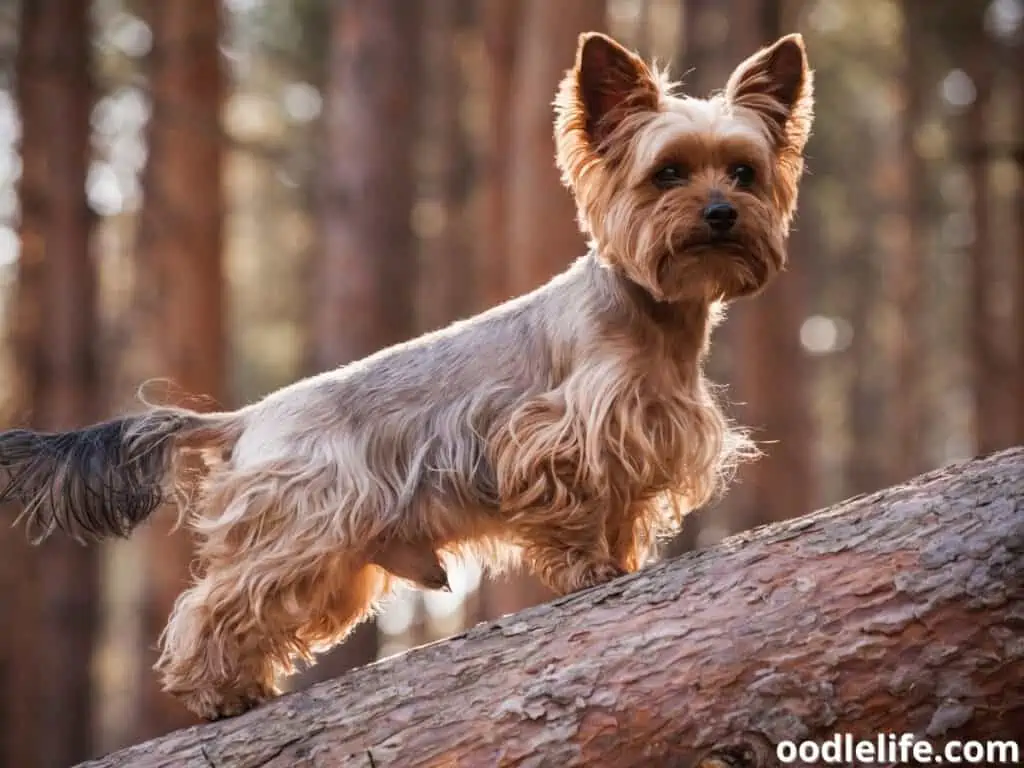Can Dogs Climb Trees? [Wow!]
We’ve all heard the tales of cats climbing trees and getting stuck – but can dogs do the same? The simple answer is no. Most domesticated dogs cannot climb trees (at least not like cats or other prehensile or arboreal animals do).
Non-domesticated dogs hunt in packs, so customarily, there’s no need to climb a tree to escape a predator or threat. The domesticated dogs of today follow a similar inclination.

Dogs, however, have a keen sense of smell and ambition, so never disregard climbing a tree as a total impossibility. If they want to, they’ll try!
Read on for specific breeds that enjoy climbing trees and their physical capabilities.
Dog Breeds Known to Climb Trees
Dogs can adapt to different environments, but they usually stick to the ground instead of defying gravity. The dog’s breed, size, and strength are all factors that affect climbing ability. Below are some traditional dog breeds known for their tree-climbing skills.

New Guinea Singing Dog
The Singing Dog is a rare breed from New Guinea Island. They have stocky bodies and pliable limbs for effortless climbing.
The New Guinea Singing Dog is a domesticated breed but tends to shy away from strangers and keep to itself. Do not confuse them with a Dingo – those dogs are much more aggressively inclined. The Singing Dog is extremely rare, with only about 300 left in captivity.
The Singing Dog has an incredible bone structure for climbing. Their spine enhances agility, and their signature short legs stretch and bend for flexibility. These dogs have joints that allow for more rotation than most domesticated dog breeds.

Louisiana Catahoula Leopard
This dog originates from North Central Louisiana in an area called Catahoula Lake. They are muscular and strong dogs that exhibit endurance and agility. Louisiana Catahoula Leopard dogs have a unique webbing on their toes effective in swampy and dank areas.
So, what makes the Louisiana Catahoula Leopard so skilled at climbing? The primary reason is their claws (and paws). The webbing between their toes allows for easy maneuvering around moist and humid climates, and their nails are long and sharp to help them grip tree bark and branches.
Even their dewclaws are longer than most dogs for grasping trunks.
Various nerves, muscles, and arterial systems connect to the paws of the Catahoula Leopard, providing plenty of blood circulation and energy ideal for climbing trees.

The Treeing Coonhound Walker
These dogs breed selectively to run down raccoons and even tree them. Other prey includes tree bobcats, small bears, and cougars – all arboreal animals. The Treeing Coonhound is not only a great climber, but they also make excellent hunting dogs.
The dogs were initially bred from Tennessee Lead dogs by Walker Foxhound. The breed is exceedingly vocal and produces bugle-like sounds during hunting.
These dogs are popularly known as People’s Choice and are said to be hot-nosed as they leave old prey to pursue new hunts. The dogs are versatile in hunting skills and can hunt individually or in a pack.

Jack Russel Terrier
One of the most well-known domestic breeds, the Jack Russel Terrier, is a force to be reckoned with, on and off the ground. Initially bred in England, the Jack Russel loves nothing more than running around outside or climbing trees.
Don’t let their size fool you. These little guys pack a punch! Also, their small stature allows them to move faster and more effectively than a large breed.
They have a strong prey drive and do well in forest hunting excursions.

Anatomical Attributes of Tree-Climbing Dogs

For a canine to climb a tree, they need particular physical characteristics. An English bulldog, for example, would not find success in climbing because of its front-heavy stature and strong-but-short bone structure.
Other essential anatomical attributes of tree-climbing dogs include:
- Long claws and limbs
- Muscular build with little-to-no excessive weight
- Flexible joints for rotation and mobility
- Small or medium stature
Mammoth breeds like a Great Dane or Saint Bernard will likely have issues climbing trees due to their size. Small and medium dogs have the most luck, especially canines with lean builds and hunting skills.
Remember that dogs do not have as flexible spines as cats – they cannot bend and twist as easily regardless of breed, but some canines have more mobility than others.
Hunting Instincts
Some breeds have a stronger will to hunt than others. Hounds, Terriers, and sporting breeds all have a powerful hunting instinct. Breeds like Pugs, however, do not have the same drive.
They still love food, but you won’t ever see one out hunting in the forest!
As mentioned earlier, hunting instincts and ambition go a long way. If a dog has the drive to catch prey that’s escaped to a tree for shelter, it’ll most likely find a way to get to it. Dogs ordinarily do not receive training to climb trees – instead, they run their desired creature up a tree and bark until their human gets it down.
Dogs are not climbers by nature. They’ve evolved strong legs for traveling long distances, but not necessarily to climb trees. Most dogs do have some degree of hunting instinct, even if they only rummage through the trash.

Self-Preservation
What comes up must come down, right? Dogs may not climb trees because they know they may fall on the way down.
Cats always land on their feet, so they don’t have any qualms about climbing trees. Canines do not have the same tendency. If a dog falls out of a tree, the chances of injury are immense – especially if the dog has previous joint damage, hip problems, or nervous system ailments.
Dogs hesitate to climb because they don’t want to hurt themselves, similar to the human habit of avoiding discomfort or risky ventures. Of course, not all dogs have a vigorous self-preservation tic. Some only care about finding their prey or escaping your newly-built fence.
It mostly depends on your dog’s disposition.

Training
If you want your dog to climb trees, you can train them to do so (if they’re the proper breed). The easiest way to train your dog to ascend trees is to entice them with treats or toys.
Begin training them slowly and establish trust. Your dog needs to know it will not hurt itself or fall. Continue doing this daily until you feel your dog is ready to hunt.

Final Thoughts
So, yes – dogs can climb trees. But that does not mean they want to or do so often. Factors like hunting instinct, physical capabilities, and natural self-preservation inclinations affect a dog’s desire to climb.
Most dogs that decide to climb choose low-hanging branches or short trees for ease of access.